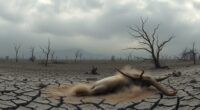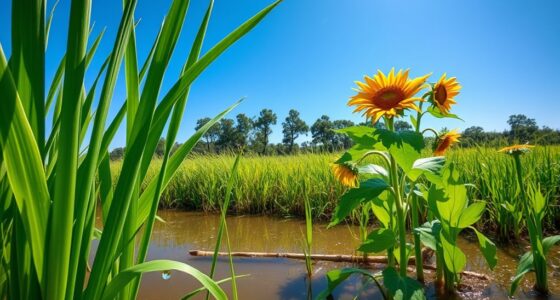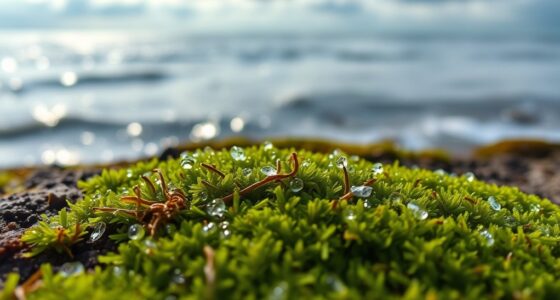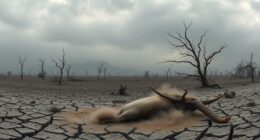When one species changes in an ecosystem, it can trigger a trophic cascade, affecting many other levels of the food chain. For example, removing a keystone predator can lead to prey overpopulation, which then impacts plants and other animals. These ripple effects can destabilize the entire ecosystem, causing unintended consequences. Understanding these interconnected relationships shows how vital each species is, and if you want to see how this process works, keep exploring further.
Key Takeaways
- Trophic cascades occur when changes in one species affect multiple levels of the food web.
- Keystone species and predators help regulate populations, preventing overgrowth and maintaining ecosystem balance.
- Removing a top predator can cause prey populations to explode, disrupting resource availability.
- These cascades influence plant growth, nutrient cycling, and overall ecosystem stability.
- Protecting key species is essential to preserve ecological balance and prevent ecosystem collapse.
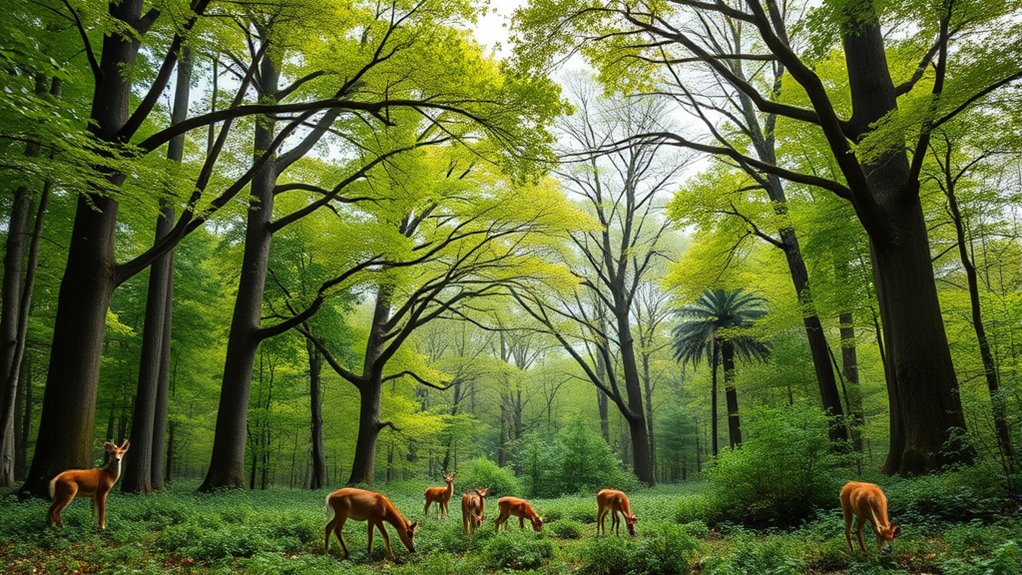
Have you ever wondered how the presence or absence of a single species can ripple through an entire ecosystem? It’s a fascinating idea, and it’s at the heart of understanding trophic cascades. These are the powerful indirect effects that occur when changes at one level of the food chain influence multiple other levels. Central to this concept are keystone species, which play outsized roles relative to their abundance. Their influence helps maintain the balance of predator-prey dynamics and overall ecosystem health.
Imagine a keystone predator that keeps a prey population in check. When this predator is present, prey numbers stay controlled, preventing them from over-consuming plants or smaller animals. This balance supports other species, preserves biodiversity, and maintains the structure of the ecosystem. But if that keystone predator disappears, prey populations can explode. This surge can lead to overgrazing or overexploitation of resources, causing a chain reaction that affects plants, herbivores, and even other predators. The entire ecosystem can shift, sometimes profoundly, illustrating the power of a single species to influence many others.
A keystone predator controls prey populations, maintaining balance and preventing ecosystem collapse.
Predator-prey dynamics are a fundamental part of these processes. They involve complex interactions where predators regulate prey populations, which in turn affects the prey’s food sources and the predators’ food sources. When predator numbers fluctuate, prey populations respond accordingly, leading to shifts up and down the food chain. These fluctuations can cascade through the ecosystem, affecting everything from plant growth to nutrient cycling. For example, in freshwater lakes, the removal of a top predator like a large fish can cause a boom in smaller fish or invertebrates, which then overconsume algae or aquatic plants. The resulting imbalance can alter water clarity, oxygen levels, and the entire aquatic community.
Understanding trophic cascades helps you see how interconnected ecosystems truly are. A change in one species’ population can trigger a domino effect, altering the environment in ways that might seem indirect but are actually profound. Recognizing keystone species and their role in predator-prey dynamics highlights the importance of preserving these critical players. Their presence helps sustain the natural checks and balances that keep ecosystems resilient and functioning properly. Creativity in conservation strategies can also benefit from understanding these complex relationships, as innovative solutions often require thinking outside traditional approaches. Without them, ecosystems risk destabilization, leading to loss of biodiversity and ecological health. So, next time you think about conservation or ecological balance, remember: sometimes, saving one species is the key to protecting many others.
Frequently Asked Questions
How Do Trophic Cascades Affect Human Agriculture?
Trophic cascades impact your agriculture by influencing crop diversity and soil health. When predator or herbivore populations shift, they affect plant growth and pest control. This can lead to more diverse crops, improving resilience, or cause soil degradation if key species decline. You need to monitor these changes to maintain healthy ecosystems, ensuring sustainable yields and protecting your soil’s robustness for future farming success.
Can Trophic Cascades Be Reversed Naturally?
Yes, trophic cascades can reverse naturally over time, thanks to ecosystem resilience and predator-prey dynamics. When the balance of predators and prey restores itself, the effects of a cascade fade, allowing the ecosystem to recover. You’ll see this happen as predator populations adjust, controlling prey numbers, and promoting the return of original species and functions. Nature’s ability to self-correct highlights the importance of maintaining healthy predator-prey relationships.
What Role Do Keystone Species Play?
Imagine you’re in a Jurassic Park, where keystone predators play a pivotal role. They maintain ecosystem stability by controlling prey populations, preventing overgrazing or overpopulation. Without these keystone predators, the balance collapses, causing trophic cascades that can devastate the environment. Your role as a keystone species is vital; it guarantees biodiversity, health, and resilience within the ecosystem, keeping everything in harmony against chaos.
Are Trophic Cascades Visible in Urban Ecosystems?
Yes, trophic cascades are visible in urban ecosystems. You can observe how urban predators like cats and birds influence bird populations and other species. When predators increase or decrease, they affect the prey populations, which then impacts plants or insects. This chain reaction shows that even in cities, changes in predator numbers can ripple through the ecosystem, illustrating the interconnectedness of urban trophic levels.
How Do Invasive Species Influence Trophic Cascades?
Invasive species profoundly influence trophic cascades by disrupting existing species interactions and causing invasive impact. As you observe, they often outcompete native species, altering predator-prey relationships and resource availability. This can weaken or strengthen trophic levels unexpectedly, leading to unforeseen ecosystem changes. You might notice shifts in biodiversity and ecosystem stability, highlighting how invasive species can destabilize the delicate balance of native food webs through their disruptive species interaction.
Conclusion
You now see how a single species can trigger a ripple effect through an entire ecosystem. For example, the reintroduction of wolves in Yellowstone led to a 70% decline in elk populations, which allowed plants and trees to flourish again. This shows just how powerful trophic cascades are—you influence more than just one creature. Next time you think about nature, remember that a small change can have a big, far-reaching impact.

